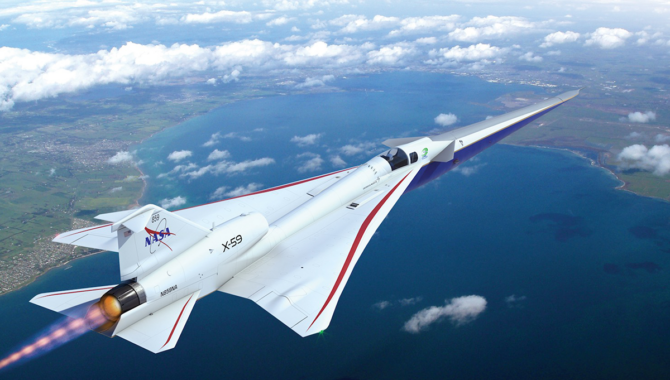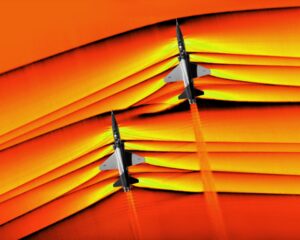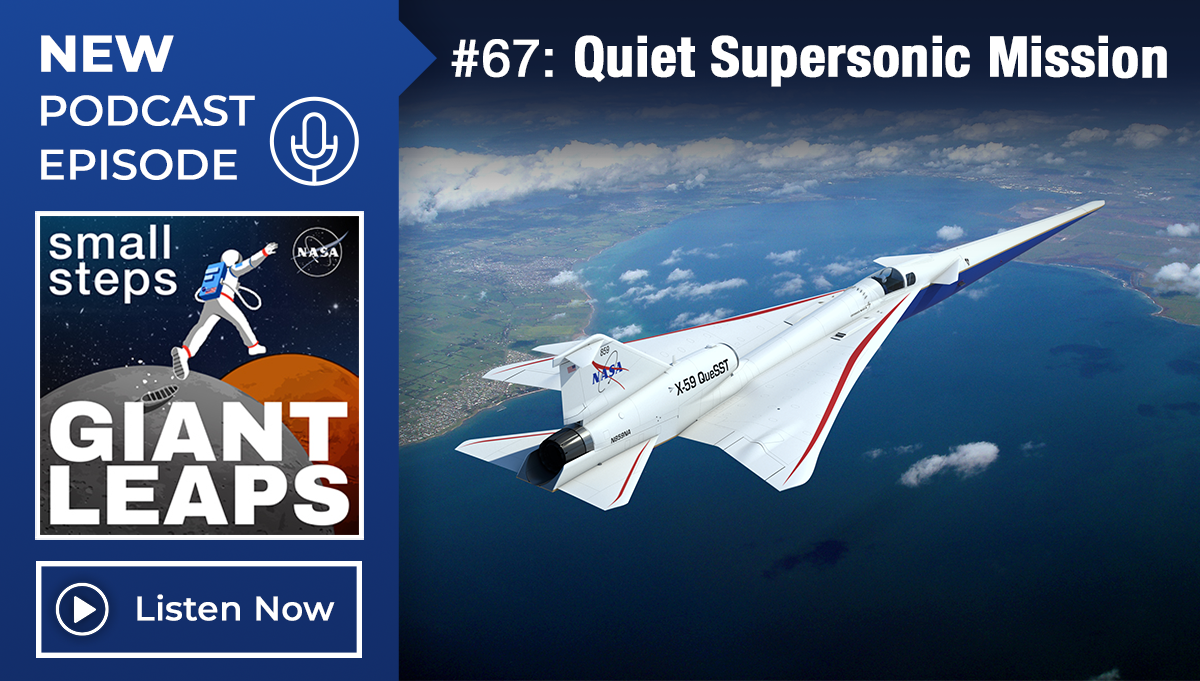
NASA’s X-59 QueSST, shown here in an artist’s illustration, has a unique design to minimize the sonic booms of supersonic flight to soft thumps. In November 2022, a GE Aviation F414-GE-100 engine was installed in the X-59 at Lockheed Martin’s Skunk Works facility in Palmdale, California, marking a major milestone as assembly of the X-59 nears completion.
Credit: Lockheed Martin
ImaginAviation session highlights promise of NASA’s X-59.
On October 14, 1947, a bright orange aircraft flew 42,000 feet above the Mojave Desert at what were then fantastic speeds. The Bell X-1 was small—just under 31 feet long—with exceptionally thin wings for the time, spanning 28 feet. At the controls was Chuck Yeager, a Captain in the U.S. Air Force who had been thrown from a horse days earlier and was nursing broken ribs. Under doctor’s orders to take it easy, Yeager worked to keep the rocket plane stable as it climbed to 43,000 feet and touched 700 miles per hour. A startling noise—like a thunderclap—reverberated across the desert floor. Aeronautics’ first sonic boom.
The 20 seconds Yeager traveled beyond the speed of sound that day ushered in the age of supersonic flight. The sound barrier, Yeager observed, … “wasn’t in the sky but in our knowledge and experience…” In the years to come, militaries around the world embraced supersonic flight. But commercial applications lagged, in no small part because of the disruptive sonic booms that led the Federal Aviation Administration to prohibit domestic civil supersonic flight over land in 1973.

Composite image of Background Oriented Schlieren (BOS) data (contour) with a cut-out images of the T-38’s during a Mach Number 1.02 pass. The interaction of the shockwave of the trailing aircraft with the exhaust plume of the lead aircraft shows a shockwave reflection. Original recording of the pass taken in the Black Mountain Supersonic Corridor at near Edwards AFB in December of 2018. Image acquired by JT Heineck, schlieren data processed by Neal Smith.
Credit: NASA/JT Heineck/Neal Smith
“A common misconception … is that the sonic boom is only created when you first pass through the speed of sound, and then you don’t have to worry about it. If only it were that easy,” said James L. Less, a research pilot and aerospace engineer at NASA’s Armstrong Flight Research Center. “… It’s not just one shock wave at the nose, but it’s a series of shock waves along the entire aircraft. The strongest ones are at the nose and at the tail. But those shock waves reach all the way to the ground, and in fact, they reach out at about 25 miles on either side of the flight path of the aircraft. And if you’re going to travel supersonic across the country, a lot of people are going to hear your boom.”
For decades, NASA and partners in government, industry, and academia have researched and tested ways to minimize sonic booms, perhaps opening the door for commercial supersonic flights over land. Less is a project pilot for an experimental new aircraft that holds the promise of reducing the thunderclap of sonic booms to much quieter thumps, similar to a car door closing. NASA developed the X-59 Quesst (Quiet Supersonic Technology) to test the effects of the plane’s unique shape and technologies at supersonic speeds.
The X-59 is a sleek and visually striking aircraft. At 99 feet, 7 inches long, it spans three X-1s. The wingspan is 29 feet, 6 inches. It is the product of decades of research and is being assembled at Lockheed Martin’s Skunk Works facility in Palmdale, California. In November 2022, it was fitted with an F414-GE-100 engine, which can produce 22,000 pounds of thrust. This will enable the X-59 to cruise as fast as Mach 1.4 and climb to an altitude of 55,000 feet.
“It’s going to weigh about 25,000 pounds at takeoff, which is actually fairly light for a supersonic airplane,” said Less, speaking at ImaginAviation, a three-day virtual event presented by the NASA Transformative Aeronautics Concepts Program to focus on the future transformation of aviation. During his presentation, Less pointed out the X-59’s long, thin fuselage. “And for now, that’s about all I’ll say about how we’re making it quiet. Long and skinny is key.”
An important element of the X-59’s design is a pronounced nose that stretches 30 feet in front of the cockpit, leaving no place for the forward-facing window that would typically inform a pilot’s flight. “That long skinny nose blocks our view of where we’re going,” Less said, noting that side visibility is also limited by the aircraft’s canards. “…One of the big innovations we needed to make this happen is what we call the eXternal Vision System (XVS).”

Because the X-59 does not have a forward facing window, the aircraft will be equipped with the eXternal Vision System, which uses multiple cameras and a high-definition monitor to provide the pilot with a view of the X-59’s flight path, augmented during takeoffs, approaches, and landings with graphical data.
Credit: Lockheed Martin/Garry Tice
The XVS employs multiple cameras and a high-definition monitor to serve the function of a front window, providing the pilot with a view of the X-59’s flight path, augmented during takeoffs, approaches, and landings with graphical data. “There’s going to be a lot of challenging aspects to flying this airplane, and not being able to see out the front being a large one of those challenges,” Less said.
Pilots have been training in a precision simulator, built from the plane’s blueprints and equipped with the same displays, seats, knobs, buttons, and switches, Less said. “By the time we get airborne in the X-59, we’re going to be pretty familiar with that cockpit. We’ve already all spent probably a hundred hours or more sitting in that cockpit, testing things out, learning how it all works.”
NASA is building toward the first flights of the X-59, which will be functional tests of the systems, and tests to demonstrate the safety and performance of the aircraft. “So, once we’ve got the airplane flying, and we’re able to go up as high and fast as we need to, we get to Phase 2, where we’re measuring the shock waves.”
During this phase of acoustic validation, the team will measure the performance of the X-59 in several ways. A modified NASA F-15 will fly close to the X-59, moving through the shock waves and measuring the pressure changes. NASA has also developed an innovative technique to take schlieren images of the airflow around the X-59 from a specially equipped F-15.
“…The innovative idea someone came up with was that if we fly across the face of the sun, relative to the camera aircraft, then those shock waves could be made visible. And it does take a lot of computer processing afterwards. That’s not something we’re seeing real time, necessarily. …To position that F-15 in just the right place to eclipse the sun with the X-59, we need to be within about 30 feet of altitude, 30 feet left of right of the correct position,” Less said.
Finally, the X-59 will fly over select cities in Phase 3, with NASA asking residents about their experiences of the thumps the X-59 produces during supersonic flight.
“It’s an exciting time to be in aviation, and I am certainly looking forward to hopping in the X-59 and ushering in a new era of quiet supersonic travel,” Less said.
To learn more about ImaginAviation and view recordings of the full program, with sessions covering everything from Aerial Innovation in Emergency Response Working Towards a Sustainable Future in 2050 and Beyond, click here.









